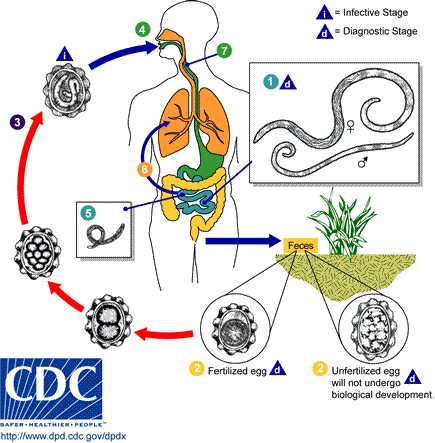 |
This is a file from the Wikimedia Commons. Information from its description page there is shown below.
Commons is a freely licensed media file repository. You can help.
|
| Description |
Adult worms 1 live in the lumen of the small intestine. A female may produce approximately 200,000 eggs per day, which are passed with the feces 2. Unfertilized eggs may be ingested but are not infective. Fertile eggs embryonate and become infective after 18 days to several weeks 3, depending on the environmental conditions (optimum: moist, warm, shaded soil). After infective eggs are swallowed 4, the larvae hatch 5, invade the intestinal mucosa, and are carried via the portal, then systemic circulation to the lungs . The larvae mature further in the lungs 6 (10 to 14 days), penetrate the alveolar walls, ascend the bronchial tree to the throat, and are swallowed 7. Upon reaching the small intestine, they develop into adult worms 8. Between 2 and 3 months are required from ingestion of the infective eggs to oviposition by the adult female. Adult worms can live 1 to 2 years. From http://www.dpd.cdc.gov/dpdx/HTML/ImageLibrary/Ascariasis_il.asp?body=A-F/Ascariasis/body_Ascariasis_il11.htm |
| Date |
2005-04-06 (original upload date) |
| Source |
Originally from en.wikipedia; description page is/was here. |
| Author |
Original uploader was Tagishsimon at en.wikipedia |
Permission
( Reusing this file) |
PD-USGOV-HHS-CDC.
|
Licensing
| Public domainPublic domainfalsefalse |
 |
This image is a work of the Centers for Disease Control and Prevention, part of the United States Department of Health and Human Services, taken or made as part of an employee's official duties. As a work of the U.S. federal government, the image is in the public domain.
česky | Deutsch | English | español | eesti | suomi | français | italiano | македонски | Nederlands | polski | português | slovenščina | 中文 | 中文(简体) | +/−
|
|
File usage
The following pages on Schools Wikipedia link to this image (list may be incomplete):
You can learn about nearly 6,000 different topics on Schools Wikipedia. Thanks to SOS Children's Villages, 62,000 children are enjoying a happy childhood, with a healthy, prosperous future ahead of them. Help another child by taking out a sponsorship



